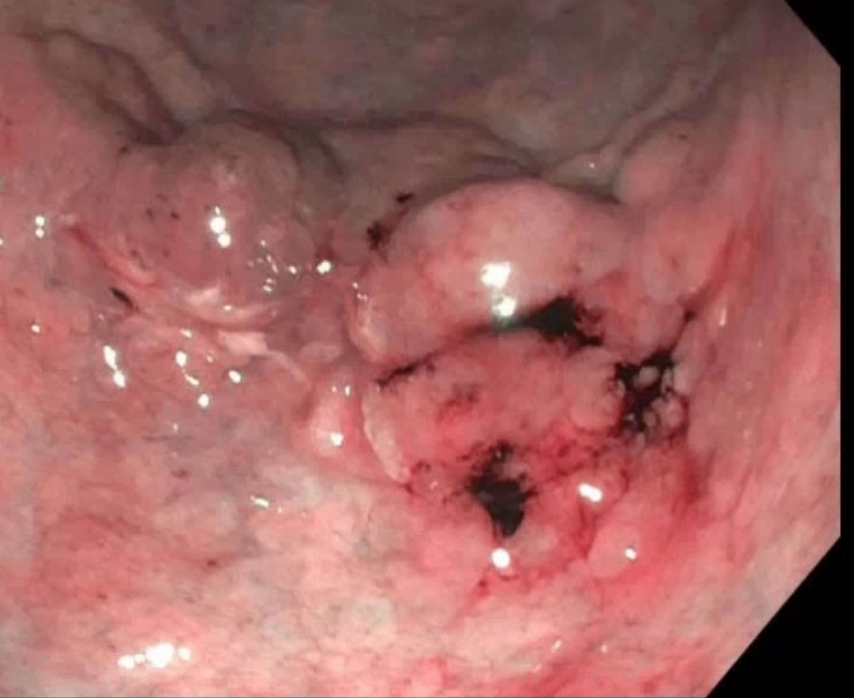Sunday Poster Session
Category: Stomach and Spleen
Coexistence of Gastric Adenocarcinoma and MALT- Lymphoma in a <i>H. pylori</i> Negative Patient: A Rare Dual Pathology
P2066 - Coexistence of Gastric Adenocarcinoma and MALT- Lymphoma in a H. pylori Negative Patient: A Rare Dual Pathology
Sunday, October 26, 2025
3:30 PM - 7:00 PM PDT
Location: Exhibit Hall
- OT
Ornela Thartori, MD
BronxCare Health System
Brooklyn, NY
Presenting Author(s)
Ornela Thartori, MD1, Priscilla Hallal, MD2, Haider Ghazanfar, MD3, Elona Shehi, MD2
1BronxCare Health System, Brooklyn, NY; 2BronxCare Health System, Bronx, NY; 3BRONX CARE HEALTH SYSTEM, Bronx, NY
Introduction: The simultaneous presence of MALT lymphoma and gastric adenocarcinoma in the stomach is an uncommon but clinically important phenomenon. Although both conditions originate in the gastric mucosa, they have distinct pathophysiological mechanisms and clinical implications. MALT lymphoma is typically linked to chronic Helicobacter pylori infection, yet some cases occur without this infection, posing unique challenges in understanding their pathogenesis and management.
Case Description/
Methods: 47-year-old woman referred to GI clinic for evaluation of IDA. EGD revealed polypoid lesion in the gastric body, which was biopsied and showed gastric adenocarcinoma, intestinal type with signet ring cells.The presence of MALT lymphoma was also confirmed in the greater curvature of the gastric body. Random biopsies from the duodenal bulb and second part of the duodenum confirmed presence of MALT lymphoma. No H. Pylori was identified in all gastric biopsies. Her prior upper endoscopies had shown diffuse intestinal metaplasia without dysplasia, and H. Pylori testing was also negative at that time.
Discussion: MALT lymphoma is a type of non-Hodgkin lymphoma that arises from lymphoid tissue associated with mucosal sites, most commonly in the stomach. It is often associated with chronic inflammation, such as that caused by H. Pylori infection. However, MALT lymphoma can develop in the absence of H. pylori, suggesting alternative pathogenic mechanisms. Gastric adenocarcinoma, particularly the subtype with signet ring cell features, is a malignant tumor of the stomach lining characterized by cells containing mucin. While H. pylori infection is a known risk factor for gastric adenocarcinoma, cases can occur without this infection, indicating that other factors, such as genetic predispositions, dietary influences, or environmental exposures, may contribute to its pathogenesis.
In patients with both MALT lymphoma and gastric adenocarcinoma who are H. pylori negative, a comprehensive diagnostic and therapeutic approach is crucial. This includes evaluating other potential causes of chronic gastric inflammation and considering the implications of having two distinct gastric pathologies, which may influence treatment strategies and prognosis. The uniqueness of this case lies in the coexistence of MALT lymphoma and adenocarcinoma without H. pylori. In such scenarios, the pathogenesis of MALT lymphoma may involve alternative mechanisms like chronic inflammation from other sources, genetic mutations, or immune dysregulation.

Figure: Image 1 (showing polypoid lesion)
Disclosures:
Ornela Thartori indicated no relevant financial relationships.
Priscilla Hallal indicated no relevant financial relationships.
Haider Ghazanfar indicated no relevant financial relationships.
Elona Shehi indicated no relevant financial relationships.
Ornela Thartori, MD1, Priscilla Hallal, MD2, Haider Ghazanfar, MD3, Elona Shehi, MD2. P2066 - Coexistence of Gastric Adenocarcinoma and MALT- Lymphoma in a <i>H. pylori</i> Negative Patient: A Rare Dual Pathology, ACG 2025 Annual Scientific Meeting Abstracts. Phoenix, AZ: American College of Gastroenterology.
1BronxCare Health System, Brooklyn, NY; 2BronxCare Health System, Bronx, NY; 3BRONX CARE HEALTH SYSTEM, Bronx, NY
Introduction: The simultaneous presence of MALT lymphoma and gastric adenocarcinoma in the stomach is an uncommon but clinically important phenomenon. Although both conditions originate in the gastric mucosa, they have distinct pathophysiological mechanisms and clinical implications. MALT lymphoma is typically linked to chronic Helicobacter pylori infection, yet some cases occur without this infection, posing unique challenges in understanding their pathogenesis and management.
Case Description/
Methods: 47-year-old woman referred to GI clinic for evaluation of IDA. EGD revealed polypoid lesion in the gastric body, which was biopsied and showed gastric adenocarcinoma, intestinal type with signet ring cells.The presence of MALT lymphoma was also confirmed in the greater curvature of the gastric body. Random biopsies from the duodenal bulb and second part of the duodenum confirmed presence of MALT lymphoma. No H. Pylori was identified in all gastric biopsies. Her prior upper endoscopies had shown diffuse intestinal metaplasia without dysplasia, and H. Pylori testing was also negative at that time.
Discussion: MALT lymphoma is a type of non-Hodgkin lymphoma that arises from lymphoid tissue associated with mucosal sites, most commonly in the stomach. It is often associated with chronic inflammation, such as that caused by H. Pylori infection. However, MALT lymphoma can develop in the absence of H. pylori, suggesting alternative pathogenic mechanisms. Gastric adenocarcinoma, particularly the subtype with signet ring cell features, is a malignant tumor of the stomach lining characterized by cells containing mucin. While H. pylori infection is a known risk factor for gastric adenocarcinoma, cases can occur without this infection, indicating that other factors, such as genetic predispositions, dietary influences, or environmental exposures, may contribute to its pathogenesis.
In patients with both MALT lymphoma and gastric adenocarcinoma who are H. pylori negative, a comprehensive diagnostic and therapeutic approach is crucial. This includes evaluating other potential causes of chronic gastric inflammation and considering the implications of having two distinct gastric pathologies, which may influence treatment strategies and prognosis. The uniqueness of this case lies in the coexistence of MALT lymphoma and adenocarcinoma without H. pylori. In such scenarios, the pathogenesis of MALT lymphoma may involve alternative mechanisms like chronic inflammation from other sources, genetic mutations, or immune dysregulation.

Figure: Image 1 (showing polypoid lesion)
Disclosures:
Ornela Thartori indicated no relevant financial relationships.
Priscilla Hallal indicated no relevant financial relationships.
Haider Ghazanfar indicated no relevant financial relationships.
Elona Shehi indicated no relevant financial relationships.
Ornela Thartori, MD1, Priscilla Hallal, MD2, Haider Ghazanfar, MD3, Elona Shehi, MD2. P2066 - Coexistence of Gastric Adenocarcinoma and MALT- Lymphoma in a <i>H. pylori</i> Negative Patient: A Rare Dual Pathology, ACG 2025 Annual Scientific Meeting Abstracts. Phoenix, AZ: American College of Gastroenterology.
